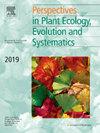种群基因组学和分类学解决了巴利阿里古特有巴利阿里雌蚊的保护难题
IF 2.9
3区 环境科学与生态学
Q1 ECOLOGY
Perspectives in Plant Ecology Evolution and Systematics
Pub Date : 2025-07-01
DOI:10.1016/j.ppees.2025.125888
引用次数: 0
摘要
对分类、分布和种内遗传多样性的深入了解对于保护狭窄的特有物种至关重要,这些物种面临着更高的灭绝风险,特别是在岛屿系统中。本文研究了巴利阿里群岛特有的一种单型植物属(菊科)。该属的唯一物种巴利亚雌蚊(Femeniasia balearica)已知的种群只有4个:其中3个在梅诺卡岛,它被认为是当地特有的,最近在马略卡岛发现了一个,怀疑是最近人为引入的结果。后一种种群带来了一个保护难题:如果引入,它可能不值得与本地种群一样的保护地位;如果是本地的,它将具有很高的生物地理和保护价值。为了解决这一问题,深入了解balearica分布的多样性和分化,我们基于质体DNA对balearica及其近缘种进行了系统发育和分化时间推断,并基于基因分型测序(GBS)对balearica种群进行了系统发育、种群基因组和聚结人口统计学分析,并进行了形态学研究。我们的研究结果揭示了上新世马略卡岛和梅诺卡岛种群之间的差异,以及形态和遗传上的显著差异,这支持了马略卡岛上早有F. balearica的存在。因此,马略卡岛的种群在这里被描述为F. balearica亚种。majoricensis。种内遗传多样性与分类学的结合研究是鉴定具有分类学、生物地理学和进化相关性的自然种群的基础。我们的研究结果应该促使人们重新考虑雌性亚种的保护和管理策略。本文章由计算机程序翻译,如有差异,请以英文原文为准。
Population genomics and taxonomy solve a conservation conundrum in the Balearic paleoendemic Femeniasia balearica
A robust understanding of taxonomy, distribution and intraspecific genetic diversity is crucial for the conservation of narrow endemic species, which face a higher risk of extinction, especially in insular systems. Here, we study the monotypic plant genus Femeniasia (Asteraceae), narrowly endemic to the Balearic Islands. Only four populations are known for the sole species of this genus, Femeniasia balearica: three on the island of Menorca, where it is considered native and endemic, and one recently discovered on the island of Mallorca, suspected to be the result of a recent anthropogenic introduction. The latter population poses a conservation conundrum: if introduced, it may not merit the same conservation status as native populations; if native, it would be of high biogeographic and conservation interest. To solve this problem and gain an in-depth understanding of diversity and differentiation across the distribution of F. balearica, we conducted phylogenetic and divergence time inference for F. balearica and its relatives based on plastid DNA, phylogenomic, population genomic and coalescent-based demographic analysis of F. balearica populations based on genotyping-by-sequencing (GBS), and a morphological study. Our findings revealed a divergence dating back to the Pliocene, and significant morphological and genetic differentiation between Mallorcan and Menorcan populations, which supports an old presence of F. balearica on Mallorca. As a result, the Mallorcan population is herein described as F. balearica subsp. majoricensis. The combined study of intraspecific genetic diversity and taxonomy proved fundamental in identifying natural populations of taxonomic, biogeographic and evolutionary relevance. Our findings should prompt a reconsideration of the conservation and management strategies of Femeniasia.
求助全文
通过发布文献求助,成功后即可免费获取论文全文。
去求助
来源期刊
CiteScore
6.50
自引率
0.00%
发文量
28
审稿时长
67 days
期刊介绍:
Perspectives in Plant Ecology, Evolution and Systematics (PPEES) publishes outstanding and thought-provoking articles of general interest to an international readership in the fields of plant ecology, evolution and systematics. Of particular interest are longer, in-depth articles that provide a broad understanding of key topics in the field. There are six issues per year.
The following types of article will be considered:
Full length reviews
Essay reviews
Longer research articles
Meta-analyses
Foundational methodological or empirical papers from large consortia or long-term ecological research sites (LTER).

 求助内容:
求助内容: 应助结果提醒方式:
应助结果提醒方式:


